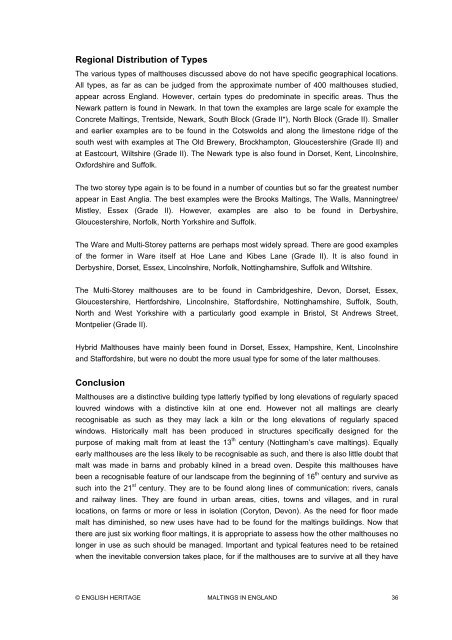Maltings in England - English Heritage
Maltings in England - English Heritage
Maltings in England - English Heritage
Create successful ePaper yourself
Turn your PDF publications into a flip-book with our unique Google optimized e-Paper software.
Regional Distribution of Types<br />
The various types of malthouses discussed above do not have specific geographical locations.<br />
All types, as far as can be judged from the approximate number of 400 malthouses studied,<br />
appear across <strong>England</strong>. However, certa<strong>in</strong> types do predom<strong>in</strong>ate <strong>in</strong> specific areas. Thus the<br />
Newark pattern is found <strong>in</strong> Newark. In that town the examples are large scale for example the<br />
Concrete <strong>Malt<strong>in</strong>gs</strong>, Trentside, Newark, South Block (Grade II*), North Block (Grade II). Smaller<br />
and earlier examples are to be found <strong>in</strong> the Cotswolds and along the limestone ridge of the<br />
south west with examples at The Old Brewery, Brockhampton, Gloucestershire (Grade II) and<br />
at Eastcourt, Wiltshire (Grade II). The Newark type is also found <strong>in</strong> Dorset, Kent, L<strong>in</strong>colnshire,<br />
Oxfordshire and Suffolk.<br />
The two storey type aga<strong>in</strong> is to be found <strong>in</strong> a number of counties but so far the greatest number<br />
appear <strong>in</strong> East Anglia. The best examples were the Brooks <strong>Malt<strong>in</strong>gs</strong>, The Walls, Mann<strong>in</strong>gtree/<br />
Mistley, Essex (Grade II). However, examples are also to be found <strong>in</strong> Derbyshire,<br />
Gloucestershire, Norfolk, North Yorkshire and Suffolk.<br />
The Ware and Multi-Storey patterns are perhaps most widely spread. There are good examples<br />
of the former <strong>in</strong> Ware itself at Hoe Lane and Kibes Lane (Grade II). It is also found <strong>in</strong><br />
Derbyshire, Dorset, Essex, L<strong>in</strong>colnshire, Norfolk, Nott<strong>in</strong>ghamshire, Suffolk and Wiltshire.<br />
The Multi-Storey malthouses are to be found <strong>in</strong> Cambridgeshire, Devon, Dorset, Essex,<br />
Gloucestershire, Hertfordshire, L<strong>in</strong>colnshire, Staffordshire, Nott<strong>in</strong>ghamshire, Suffolk, South,<br />
North and West Yorkshire with a particularly good example <strong>in</strong> Bristol, St Andrews Street,<br />
Montpelier (Grade II).<br />
Hybrid Malthouses have ma<strong>in</strong>ly been found <strong>in</strong> Dorset, Essex, Hampshire, Kent, L<strong>in</strong>colnshire<br />
and Staffordshire, but were no doubt the more usual type for some of the later malthouses.<br />
Conclusion<br />
Malthouses are a dist<strong>in</strong>ctive build<strong>in</strong>g type latterly typified by long elevations of regularly spaced<br />
louvred w<strong>in</strong>dows with a dist<strong>in</strong>ctive kiln at one end. However not all malt<strong>in</strong>gs are clearly<br />
recognisable as such as they may lack a kiln or the long elevations of regularly spaced<br />
w<strong>in</strong>dows. Historically malt has been produced <strong>in</strong> structures specifically designed for the<br />
purpose of mak<strong>in</strong>g malt from at least the 13 th century (Nott<strong>in</strong>gham’s cave malt<strong>in</strong>gs). Equally<br />
early malthouses are the less likely to be recognisable as such, and there is also little doubt that<br />
malt was made <strong>in</strong> barns and probably kilned <strong>in</strong> a bread oven. Despite this malthouses have<br />
been a recognisable feature of our landscape from the beg<strong>in</strong>n<strong>in</strong>g of 16 th century and survive as<br />
such <strong>in</strong>to the 21 st century. They are to be found along l<strong>in</strong>es of communication: rivers, canals<br />
and railway l<strong>in</strong>es. They are found <strong>in</strong> urban areas, cities, towns and villages, and <strong>in</strong> rural<br />
locations, on farms or more or less <strong>in</strong> isolation (Coryton, Devon). As the need for floor made<br />
malt has dim<strong>in</strong>ished, so new uses have had to be found for the malt<strong>in</strong>gs build<strong>in</strong>gs. Now that<br />
there are just six work<strong>in</strong>g floor malt<strong>in</strong>gs, it is appropriate to assess how the other malthouses no<br />
longer <strong>in</strong> use as such should be managed. Important and typical features need to be reta<strong>in</strong>ed<br />
when the <strong>in</strong>evitable conversion takes place, for if the malthouses are to survive at all they have<br />
© ENGLISH HERITAGE MALTINGS IN ENGLAND 36
















